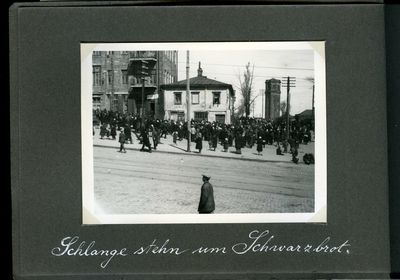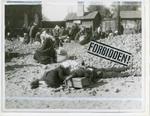Large crowd of people waiting outside a Khatorh for black bread
Description
- Creator
- Wienerberger, Alexander, 1891-1955, Photographer
- Media Type
- Image
- Text
- Item Types
- Photographs
- Photograph albums
- Description
- Hundreds of people are crowded around the front and to the side of what the photographer indicates is a place to get bread. The entrance to the store is just to the left of the white building; above the door is a temporary sign that reads “Хаторг”. A “Хаторг" or Khatorh (abbreviation of: Kharkiv Trade Organization) was one of several types of food access centers created or repurposed in the early 1930s to manage the sharply diminishing food supply for the greatly expanded urban and industrial population. This establishment is most likely selling goods for residents with ration cards; however, it is possible that it had been repurposed in 1933 to sell bread for rubles (Wienerberger, Osokina) (more details in the "Context note" at right.)
At this Khatorh, the door appears to be open, but the large waiting crowd is an indication that supply and delivery is not meeting the demand for the basic necessities that can be obtained here.
Kharkiv historians say that this location is at the intersection of the street once called Sverdlova /Свердлова (now Poltavsʹkyy Shlyakh /Полтавський Шлях) and Rylyeyeva /Рилєєва. For a very similar photo taken shortly before this one, see PD100: http://vitacollections.ca/HREC-holodomorphotodirectory/3636347/data
The caption in the Brüder in Not! pamphlet (1934) listed in the “Photo History” Related Feature, states that the photo was taken in autumn 1933. This is most likely a misstatement, since Wienerberger implies in his memoir that he left Kharkiv in the late summer. Although the warmly dressed people and the leafless tree could signify late autumn, it could also signify early to mid-spring.
For further information on: Availability and access to food in urban and industrial areas, see "Context Note" under Related Features at right.
- Notes
- Photo source: Wienerberger, Alexander. Die Hungertragödie in Südrussland 1933; also known as the Innitzer Album, 1934. P.2.
This is one of 25 photographs depicting life and death in and around Kharkiv during the Holodomor that the photographer put together in a small album with a handwritten title: Die Hungertragödie in Südrussland 1933 [The Tragedy of Famine in South Russia 1933.] He presented the album to the Roman Catholic Cardinal Theodor Innitzer of Vienna in 1934 as an expression of appreciation for the Cardinal’s efforts in trying to organize an international campaign to assist the victims of starvation in 1933. The album is housed in the collections of the Diözesanarchiv, Vienna, Austria.
For essays and a listing of originals and versions published through 1939 with their captions, check menus on right. - Inscriptions
- Handwritten caption in album: "Schlange stehn um Schwarzbrot." [Standing in line for black bread.]
- Date of Original
- spring-summer 1933
- Image Dimensions
-
Image Width: 10.8cm
Image Height: 7.9cm
- Subject(s)
- Local identifier
- PD3
- Collection
- Alexander Wienerberger: Innitzer album
- Language of Item
- German
- Geographic Coverage
-
-
Kharkiv, Ukraine
Latitude: 49.98081 Longitude: 36.25272
-
- Copyright Statement
- Protected by copyright: Uses other than research or private study require the permission of the rightsholder(s). Responsibility for obtaining permissions and for any use rests exclusively with the user.
- Copyright Holder
- Samara Pearce https://www.samarapearce.com/
- Recommended Citation
- Wienerberger, Alexander. 1933. "Schlange stehn [sic] um Schwarzbrot," in: Die Hungertragödie in Südrussland 1933. Vienna: Diözesanarchiv der Erzdiözese, [1934]. p.2. Retrieved from: http://vitacollections.ca/HREC-holodomorphotodirectory/3636354/data
- Location of Original
- Diözesanarchiv - Bibliothek, Vienna, Austria. Please contact this archive for official reproductions.
- Terms of Use
- Rightsholder requests that the name of the photographer, Alexander Wienerberger, accompany each authentic reproduction of his work.
- Reproduction Notes
- Reproduced with the permission of rightsholder Samara Pearce and the Diözesanarchiv - Bibliothek, Vienna, Austria.




